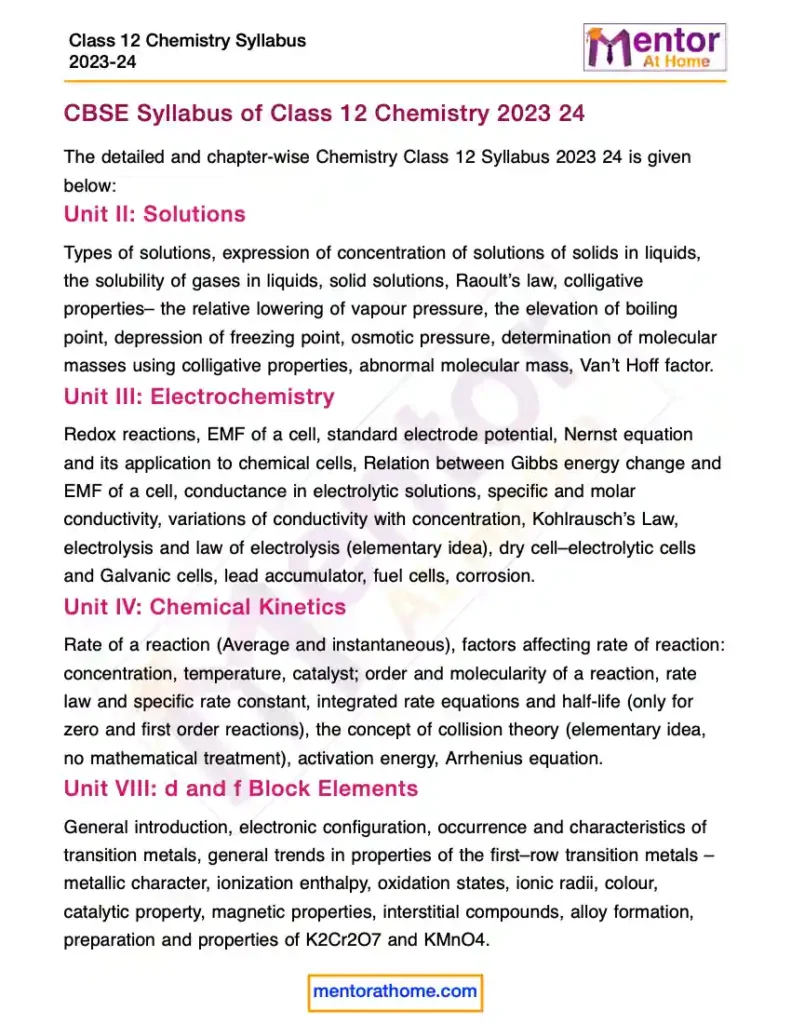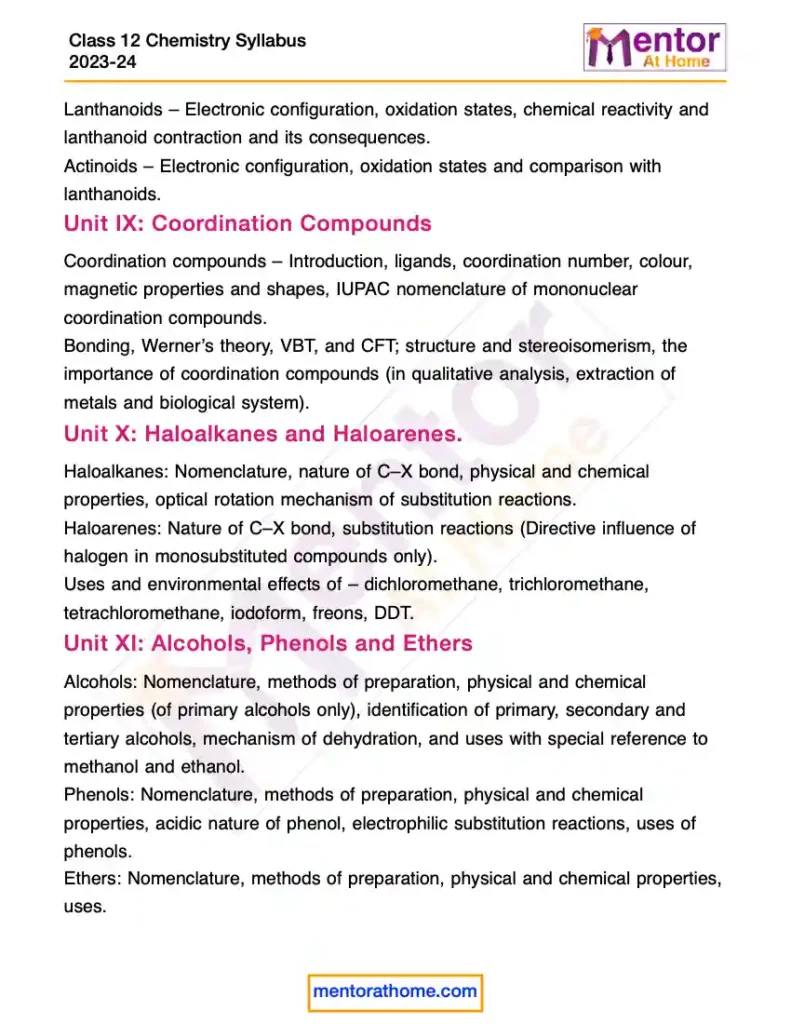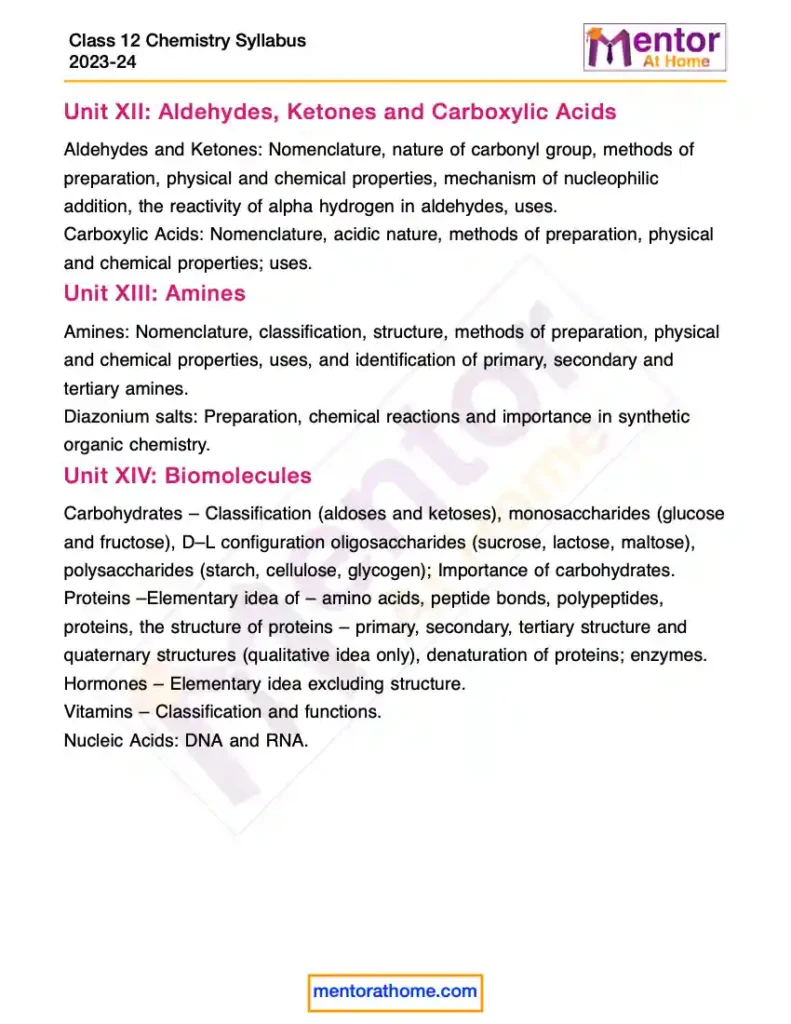CBSE Class 12 Chemistry Syllabus 2023-24 | Class 12th Chemistry Syllabus
Here we provide the latest CBSE Class 12 Chemistry Syllabus 2023 24. You can also Download the new and revised CBSE Chemistry syllabus class 12 PDF. The present revised syllabus of class 12 Chemistry has been designed in accordance with National Curriculum Framework 2005.
Chemistry is a scoring subject but needs a lot of practice and conceptual understanding of the topics. CBSE Chemistry syllabus class 12 helps you understand the important topics. We advise you to read the CBSE class 12 Chemistry syllabus 2023 24 carefully. Class 12th Chemistry syllabus also helps you in preparation for competitive exams like IIT, AIEEE etc.
You may also like
- Class 12 NCERT Solution
- Class 12 NCERT Books
- Class 12 NCERT Notes
- Class 12 Syllabus for all Subjects
CBSE Class 12 Chemistry Syllabus 2023-24 Pdf
Click here to download Class 12th Chemistry Syllabus Pdf
CBSE Syllabus of Class 12 Chemistry 2023 24
The detailed and chapter-wise Chemistry Class 12 Syllabus 2023 24 is given below:
Unit II: Solutions
Types of solutions, expression of concentration of solutions of solids in liquids, the solubility of gases in liquids, solid solutions, Raoult’s law, colligative properties– the relative lowering of vapour pressure, the elevation of boiling point, depression of freezing point, osmotic pressure, determination of molecular masses using colligative properties, abnormal molecular mass, Van’t Hoff factor.
Unit III: Electrochemistry
Redox reactions, EMF of a cell, standard electrode potential, Nernst equation and its application to chemical cells, Relation between Gibbs energy change and EMF of a cell, conductance in electrolytic solutions, specific and molar conductivity, variations of conductivity with concentration, Kohlrausch’s Law, electrolysis and law of electrolysis (elementary idea), dry cell–electrolytic cells and Galvanic cells, lead accumulator, fuel cells, corrosion.
Unit IV: Chemical Kinetics
Rate of a reaction (Average and instantaneous), factors affecting rate of reaction: concentration, temperature, catalyst; order and molecularity of a reaction, rate law and specific rate constant, integrated rate equations and half-life (only for zero and first order reactions), the concept of collision theory (elementary idea, no mathematical treatment), activation energy, Arrhenius equation.
Unit VIII: d and f Block Elements
General introduction, electronic configuration, occurrence and characteristics of transition metals, general trends in properties of the first–row transition metals – metallic character, ionization enthalpy, oxidation states, ionic radii, colour, catalytic property, magnetic properties, interstitial compounds, alloy formation, preparation and properties of K2Cr2O7 and KMnO4.
Lanthanoids – Electronic configuration, oxidation states, chemical reactivity and lanthanoid contraction and its consequences.
Actinoids – Electronic configuration, oxidation states and comparison with lanthanoids.
Unit IX: Coordination Compounds
Coordination compounds – Introduction, ligands, coordination number, colour, magnetic properties and shapes, IUPAC nomenclature of mononuclear coordination compounds.
Bonding, Werner’s theory, VBT, and CFT; structure and stereoisomerism, the importance of coordination compounds (in qualitative analysis, extraction of metals and biological system).
Unit X: Haloalkanes and Haloarenes.
Haloalkanes: Nomenclature, nature of C–X bond, physical and chemical properties, optical rotation mechanism of substitution reactions.
Haloarenes: Nature of C–X bond, substitution reactions (Directive influence of halogen in monosubstituted compounds only).
Uses and environmental effects of – dichloromethane, trichloromethane, tetrachloromethane, iodoform, freons, DDT.
Unit XI: Alcohols, Phenols and Ethers
Alcohols: Nomenclature, methods of preparation, physical and chemical properties (of primary alcohols only), identification of primary, secondary and tertiary alcohols, mechanism of dehydration, and uses with special reference to methanol and ethanol.
Phenols: Nomenclature, methods of preparation, physical and chemical properties, acidic nature of phenol, electrophilic substitution reactions, uses of phenols.
Ethers: Nomenclature, methods of preparation, physical and chemical properties, uses.
Unit XII: Aldehydes, Ketones and Carboxylic Acids
Aldehydes and Ketones: Nomenclature, nature of carbonyl group, methods of preparation, physical and chemical properties, mechanism of nucleophilic addition, the reactivity of alpha hydrogen in aldehydes, uses.
Carboxylic Acids: Nomenclature, acidic nature, methods of preparation, physical and chemical properties; uses.
Unit XIII: Amines
Amines: Nomenclature, classification, structure, methods of preparation, physical and chemical properties, uses, and identification of primary, secondary and tertiary amines.
Diazonium salts: Preparation, chemical reactions and importance in synthetic organic chemistry.
Unit XIV: Biomolecules
Carbohydrates – Classification (aldoses and ketoses), monosaccharides (glucose and fructose), D–L configuration oligosaccharides (sucrose, lactose, maltose), polysaccharides (starch, cellulose, glycogen); Importance of carbohydrates.
Proteins –Elementary idea of – amino acids, peptide bonds, polypeptides, proteins, the structure of proteins – primary, secondary, tertiary structure and quaternary structures (qualitative idea only), denaturation of proteins; enzymes. Hormones – Elementary idea excluding structure.
Vitamins – Classification and functions.
Nucleic Acids: DNA and RNA.
Booklist to Cover the Class 12 Chemistry Syllabus
- Chemistry Part –I, Class–XII, Published by NCERT.
- Chemistry Part –II, Class–XII, Published by NCERT.
- Laboratory Manual of Chemistry, Class XI Published by NCERT
- Other related books and manuals of NCERT including multimedia and online sources
Class 12 Chemistry Syllabus 2023- 24 – Course Structure
Before you read the Class 12th chemistry syllabus you have to understand the course structure to complete the chemistry syllabus of class 12
| S.No | Title | No. of Periods | Marks |
| 1 | Solutions | 10 | 7 |
| 2 | Electrochemistry | 12 | 9 |
| 3 | Chemical Kinetics | 10 | 7 |
| 4 | d -and f -Block Elements | 12 | 7 |
| 5 | Coordination Compounds | 12 | 7 |
| 6 | Haloalkanes and Haloarenes | 10 | 6 |
| 7 | Alcohols, Phenols and Ethers | 10 | 6 |
| 8 | Aldehydes, Ketones and Carboxylic Acids | 10 | 8 |
| 9 | Amines | 10 | 6 |
| 10 | Biomolecules | 12 | 7 |
| Total | 70 |


